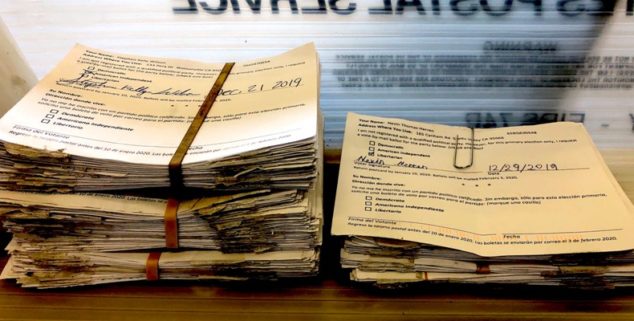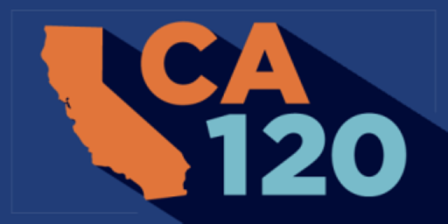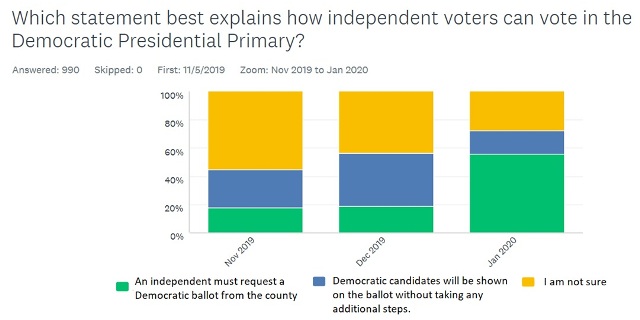News
CA120: In California, Super Tuesday means super confusion
 Voter registration forms at the Santa Cruz County registrar's office. (Photo: Political Data, Inc.)
Voter registration forms at the Santa Cruz County registrar's office. (Photo: Political Data, Inc.)In less than four weeks, 15 million Californians will be receiving ballots in the mail for the March 2020 primary.
Just under 4 million Republicans will have an opportunity to reaffirm their support for Donald Trump, or select from a few little-known challengers.
Around 7 million Democrats will see a host of well-known candidates, many of whom have been barnstorming the state in search of voters, endorsements and fundraising.
And what about the 4 million-plus independent voters who are eligible to vote in the Democratic Primary? Most will see no presidential candidates at all.
What??
Yes. On March 3, 2020, in one of the hottest primary elections in recent history, where California is set to play a more important role than usual as the largest state on Super Tuesday, there will be approximately 3.5 million voters receiving blank presidential ballots. That’s more blank ballots in California than there are potential Democratic presidential primary voters in all four early primary/caucus states, combined.
While this is shocking, we’ve been writing about it in advance of the 2020 Primary here, and during the 2016 primary here and here.
Most voters know that independent voters are allowed to vote in the Democratic Primary as they allow crossover voting in the primary making it “open” to millions of nonpartisan registrants.
How does this happen?
As has been chronicled in recent editorials in the Sacramento Bee and Los Angeles Times, and blasted all over social media, voters who are nonpartisan in California have a right to vote in the Democratic primary.
But there’s a hurdle – and it turns out to be a big one.
Most voters know that independent voters are allowed to vote in the Democratic Primary as they allow crossover voting in the primary making it “open” to millions of nonpartisan registrants. Republicans, only allow registered Republican voters to cast ballots in their primary, so it is “closed.”Voter registration forms
What most don’t know is the process by which an independent voter crosses over to the Democratic primary for the presidential race – and it’s a particularly archaic process that hasn’t kept up with California’s changing California electorate and shifting laws in the state that have been used to increase voter participation in all the other non-presidential contests.
According to how the state follows national party rules, nonpartisan voters must affirmatively request a partisan ballot in an open primary.
That’s easy when you’re a poll voter – you just get the correct ballot when you show up. But when you’re set to receive your ballot in the mail, you have to tell the county what partisan ballot you want ahead of time (choices are Democratic, Libertarian and American Independent, which is another problem we will get to here shortly).
Partisan races for the last several election cycles have included all candidates on the same ballot.
And the most common way voters are expected to get that proper ballot is by returning a postcard that was mailed to them over the holidays.
This whole thing runs incredibly counter to how we run all of the rest of our elections in California. Partisan races for the last several election cycles have included all candidates on the same ballot. The top-two system might have its faults, but it is at least easy to understand now that voters have done it in a few election cycles. You can just vote for whatever candidate you want, from whatever party, and the top vote-getters go to the general election.
And many voters who found one of these postcards among the holiday greetings and catalogs would have likely not known that it really applied to them.
There are two factors that contribute to this confusion:
First, the state, under the Voters Choice Act, has been advancing more vote-by-mail in the past two election cycles. Now, 14 counties are mailing ballots to all voters, and Los Angeles is significantly increasing their mailed ballots. This means that millions of voters who never signed up as a permanent by-mail voter will be getting a ballot in the mail in 2020. Those voters might have seen the postcard and thought it didn’t impact them.
Capitol Weekly has been reaching out to county registrars across California to try and get a feel for how the process has been working.
Secondly, there are hundreds of thousands of new No Party Preference voters who obtained that registration at the DMV during a period from May to December of 2018 during which the software was making it much more likely that a voter, often unknowingly, would rush though the process of registering and fail to select a political party. Polling shows that these voters often believe they are Democrat or Republican, and would also think that they are not meant to be getting this notice.
These two complications are beyond what we saw in 2016, exacerbating a problem that serves to disenfranchise voters who can’t overcome the crossover application hurdle.
The Scale of the problem is Mind Blowing
For the past several weeks, Capitol Weekly has been reaching out to county registrars across California to try and get a feel for how the process has been working. Here’s the breakdown from 41 counties that have reported to us their crossover ballot application response rates to date.
Their transparency and commitment to this work is reassuring, but the results are not.
| County | Mailed Crossover Apps | Returned Crossover | Percentage |
| Amador | 4,785 | 417 | 9% |
| Butte | 29,204 | 2,600 | 9% |
| Calaveras | 6,848 | 439 | 6% |
| Colusa | 1,467 | 73 | 5% |
| Contra Costa | 120,000 | 17,000 | 14% |
| Del Norte | 2,198 | 165 | 8% |
| El Dorado | 29,290 | 4,500 | 15% |
| Fresno | 115,943 | 6,000 | 5% |
| Glenn | 3,130 | 110 | 4% |
| Humboldt | 11,583 | 1,066 | 9% |
| Imperial | 13,855 | 31 | 0.2% |
| Inyo | 1,352 | 184 | 14% |
| Kern | 65,175 | 1,515 | 2% |
| Lassen | 1,582 | 174 | 11% |
| Los Angeles | 919,354 | 42,000 | 5% |
| Madera | 14,991 | 1,218 | 8% |
| Marin | 31,168 | 4,635 | 15% |
| Mendocino | 8,534 | 839 | 10% |
| Merced | 17,704 | 300 | 2% |
| Mono | 1,216 | 140 | 12% |
| Monterey | 36,064 | 3,292 | 9% |
| Napa | 21,253 | 2,758 | 13% |
| Nevada | 15,833 | 1,500 | 9% |
| Orange | 427,211 | 29,963 | 7% |
| Placer | 43,389 | 6,865 | 16% |
| Plumas | 2,516 | 456 | 18% |
| Sacramento | 210,500 | 21,150 | 10% |
| San Benito | 7,975 | 500 | 6% |
| San Bernardino | 168,490 | 6,500 | 4% |
| San Diego | 375,707 | 49,000 | 13% |
| San Francisco | 107,542 | 12,093 | 11% |
| San Mateo | 127,492 | 12,000 | 9% |
| Santa Barbara | 42,000 | 4,200 | 10% |
| Santa Clara | 298,057 | 30,000 | 10% |
| Santa Cruz | 27,032 | 2,500 | 9% |
| Sierra | 482 | 1 | 0.2% |
| Solano | 43,468 | 5,608 | 13% |
| Sonoma | 52,164 | 4,000 | 8% |
| Trinity | 1,358 | 139 | 10% |
| Tulare | 29,185 | 785 | 3% |
| Yolo | 21,259 | 884 | 4% |
You don’t have to do the math; we have. The current reported returns have just 8% of independent voters that are eligible for a presidential ballot set to receive one in February.
Clearly, not all nonpartisan votes want to vote for one of the Democratic presidential candidates. But our research, from over 10,000 surveys completed since April of 2019, show that the overwhelming number of them do.
Among the 4.2 million nonpartisan voters, about two-thirds say they want to vote in the Democratic primary. Among the 2.3 million nonpartisans that fall into Political Datat’s “likely voter” universe, that number grows to 89%.
Remember the problems with voters registering as “American Independent” because they wanted to be “independent” and didn’t understand the “no party preference” labeling? Well, they’re back.
Yet, statewide, we are projecting just 8%, or less than 400,000 partisan ballots will be mailed, and 3.6 million nonpartisan voters will get a ballot with no presidential candidates at all.
There’s confusion in the confusion
As recently tweeted by CA120, we have received from counties examples of ballots where voters sent back blank cards, wrote in that they wanted all the candidates from all the parties on their ballot, or simply wrote in “Republican” because they were confused about what the card was for.
These applications must now be re-processed, either by having a county registrar resend a postcard, call or email the voter, or simply hope they will realize that their ballot doesn’t have the presidential election that they were hoping for and understand, somehow, the process for obtaining a replacement ballot.
But it gets worse.
Remember the problems with voters registering as “American Independent” because they wanted to be “independent” and didn’t understand the “no party preference” labeling? Well, they’re back.
We asked for the partisan breakdown of returned cards, knowing that the vast majority of voters would be requesting the Democratic primary ballot, but some could pick Libertarian or American Independent, despite nobody on either of those ballots being exactly a household name.
What we found was reminiscent of the initial problem.
On average, based on counties that could report the partisan breakdown, 8% of them, or approximately 32,000, have requested AIP ballots. And the problem is different based on county, with some counties, like Orange County (which has an option for “no party preference” on their application) at just 2% AIP ballot requests. However, Amador, Trinity, Solano and Merced Counties all show 15%-to-21% AIP Applications.
And these are mistakes.
County officials are already concerned that these voters are going to have to request second ballots when they realize their ballots don’t have the candidates they intended.
This is clearly a challenge on the plates of every national presidential campaign headed to California, and it’s readily apparent to any observer.
In 2016, we saw 31,000 API ballot requests from by-mail voters, and more than half of those voters threw them away and didn’t vote in the election. This wasn’t as big of a problem at the polling locations, where less than 5,000 voters obtained an AIP ballot, presumably because there was someone there to correct them or there was a way to immediately remedy the problem once it was recognized.
Statewide, in 2016 there were a total of 36,000 voters with AIP ballots by request, plus another 100,000 registered AIP voters who went to the polls. Yet all of the AIP presidential votes cast totaled just 42,000, meaning that 70% of voters with AIP ballots in hand didn’t vote in the presidential contest. (In the end, the AIP didn’t even respect the outcome of that contest and declared Donald Trump their nominee.)
The challenges for campaigns
This is clearly a challenge on the plates of every national presidential campaign headed to California, and it’s readily apparent to any observer. With a 15% threshold required to obtain any delegates in a congressional district, having your supporters receive Democratic ballots with your name on it should be the upmost concern.
But the responsibility doesn’t stop there.
Getting nonpartisan voters to receive a Democratic ballot could also be the easiest turnout strategy for Democratic and progressive candidates across the state. Looking at 2016 figures, those who completed a crossover ballot application constituted a turnout of 81% turnout, while those who didn’t get a Democratic ballot amounted to only 26%.
Prior to the December mailings by counties and increased media attention, a significant minority of independent voters understood that they had to request a ballot.
Having a Democratic ballot in hand might not cause a voter to participate in March, but it is very clear from the data and survey research that voters who found no presidential candidates on their ballot in 2016 were more likely to skip voting entirely, rather than completing a ballot that lacked the presidential contest.
But, all the news isn’t bad, and there are remedies
We’ve found that registrars in most counties are aggressively communicating with the public on these and other issues. Several are pointing out their outreach includes additional emails to voters, a willingness to receive application requests by phone or email (not allowed in 2016), additional mailings that will be sent to voters even this coming week, and a clear policy of quickly replacing any ballots voters receive without the presidential ballots if they turn in a late crossover application or contact the offices.
Under the law, any voter who obtains an incorrect ballot can simply request a replacement, or redo the crossover ballot application card any time before Feb. 25. Political Data even has forms, by county, that help facilitate this.
Apparently, the informational campaigns by the registrars and media has seemingly paid off.
Data from the Capitol Weekly tracking survey shows that prior to the December mailings by counties and increased media attention, a significant minority of independent voters understood that they had to request a ballot, with the most voters believing they didn’t have to do anything to get the Democratic candidates on their ballot (like any other contest for congress, Legislature, or statewide office), or that they weren’t sure.
But these numbers have flipped, and it’s happened more rapidly than we almost ever see with a polling response.

Currently, 56% of these voters understand that they are required to get their crossover ballot from the county.
But this has caveats. These voters are respondents to an online poll sent to their registered voter address. These voters also likely received emails from the presidential campaigns, elected officials, county registrars, the secretary of state and others informing them of the process.
These were most likely high-touch recipients of this information from multiple sources – it is unlikely this is truly representative of the voting population as a whole.
And, this isn’t consistent with the low return rates to date. But it is still a positive finding that should be a credit to the work of many people trying to fix this problem.
Same-day Registration could be the final alternative, and probably the most expansive last minute escape hatch for these voters.
Another remedy could be just re-registering. There has been a spike in these re-registrations — something that county registrars and campaigns have been also promoting.
Those voters who are NPP and didn’t know it, or who didn’t want to mess with the crossover ballot application process, or who didn’t realize that they had to be Republican to vote in the Republican primary, are re-registering as a way of resolving the issue and can do so with the state’s online system until Feb. 25.
Same-day Registration could be the final alternative, and probably the most expansive last minute escape hatch for these voters. Any voter who hasn’t already returned a by-mail ballot can walk into their local precinct or vote center and simply re-register with the party they wish to, and cast the appropriate ballot. All of these registrations can be verified and the ballots counted.
Data on these crossovers and partisan re-registrations in advance of the March Primary will be coming in on a daily basis for the next two months. Watch our twitter account to keep updated.
—
Editor’s Note: Paul Mitchell, a regular contributor to Capitol Weekly, is the creator of the CA120 column, vice president of Political Data and owner of Redistricting Partners, a political strategy firm.
Want to see more stories like this? Sign up for The Roundup, the free daily newsletter about California politics from the editors of Capitol Weekly. Stay up to date on the news you need to know.
Sign up below, then look for a confirmation email in your inbox.

Leave a Reply